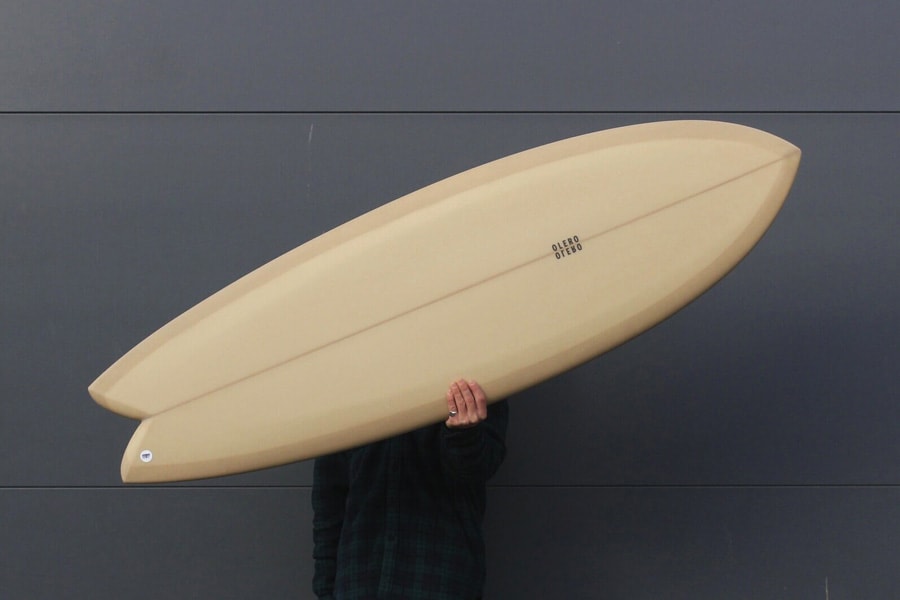
The fish surfboard is one of my go-to boards because I find that people respect me more with a fish under my arm. Just kidding. That’s not the reason at all. Although, I have had my fair share of random compliments from complete strangers passing by as recent as last week. “Nice fish,” he said. “Thanks.” I replied. Riveting, I know.
Anyways, the real reason that my fish surfboard is one of my go-to boards is that I live in San Diego, where small and mushy surf is commonplace and I’ve found that my fish is a great option to surf in average conditions. And beyond that, drum roll please… fish surfboards are a helluva lot of fun to surf.
I wrote this article because I love my fish and I think every surfer should have one. If you’re interested in learning more about fish surfboards, you’re in the right place. I’ll be covering everything from what makes a fish a fish, a little history on how the fish came to be, the variety of conditions that fish are good for, and some frequently asked questions about fish surfboards.
Let’s dive in.
The Fish Surfboard
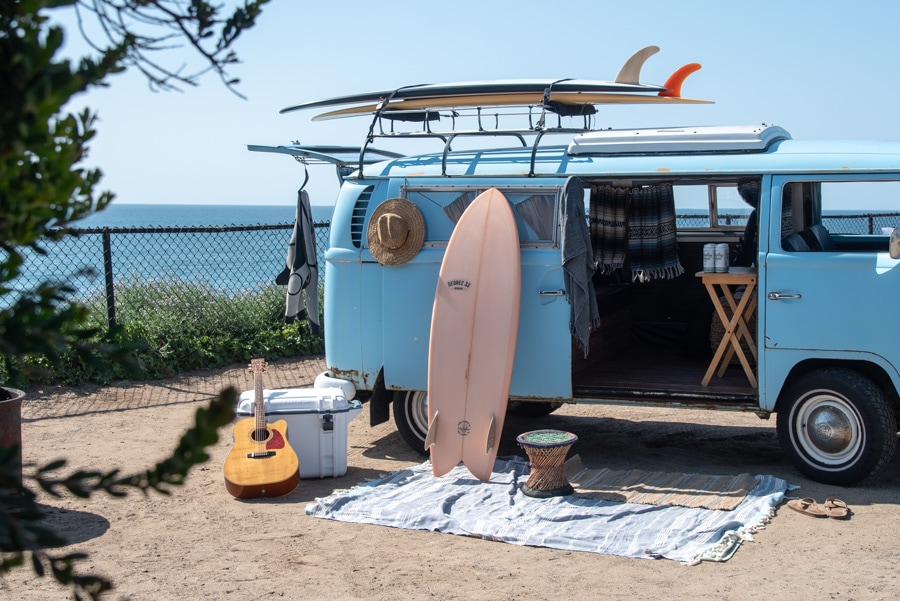
When most people think of or refer to a fish surfboard, they are likely referring to a short, wide, flat, and thicker-than-normal surfboard with a bit of volume and a fish-like swallow tail. These are some of the most common defining characteristics of a fish.
That being said, a fish surfboard can come in all sorts of shapes and sizes. From your typical 5 foot something standard fish to 7 or 8 foot plus mega fish, and everything in between. Generally speaking though, for a classic retro fish surfboard design, most surfers ride a fish that is about 2 – 6 inches shorter than they are tall depending on their weight. For example, I’m 6’1 ¾” and I surf a 5’8”. Although, I’d probably go for a 5’10” these days as sometimes I wish I had a little more length.
Features of a Fish
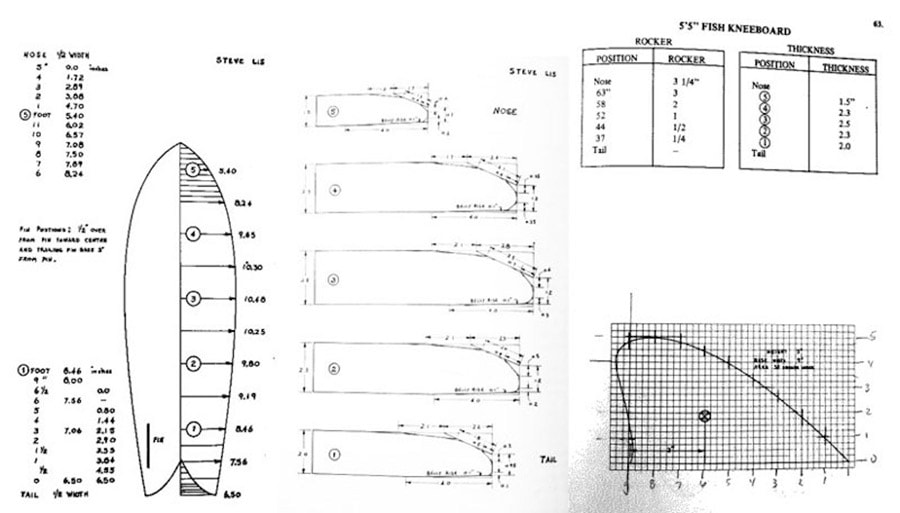
- Nose: wide but still comes to a point at the tip
- Rocker: not much, typically pretty flat
- Rails: tend to be medium to full due to thickness
- Tail: very fish-y, you known, like a fish tail
- Width: an inch or three wider than a normal shortboard
- Thickness: a bit thicker than a standard shortboard
- Volume: usually a little more than you normally ride but not always
- Fin set up: twins and quads reign but whatever floats your boat
- Construction: poly, epoxy, and soft top foamie
Fish Fin Setups
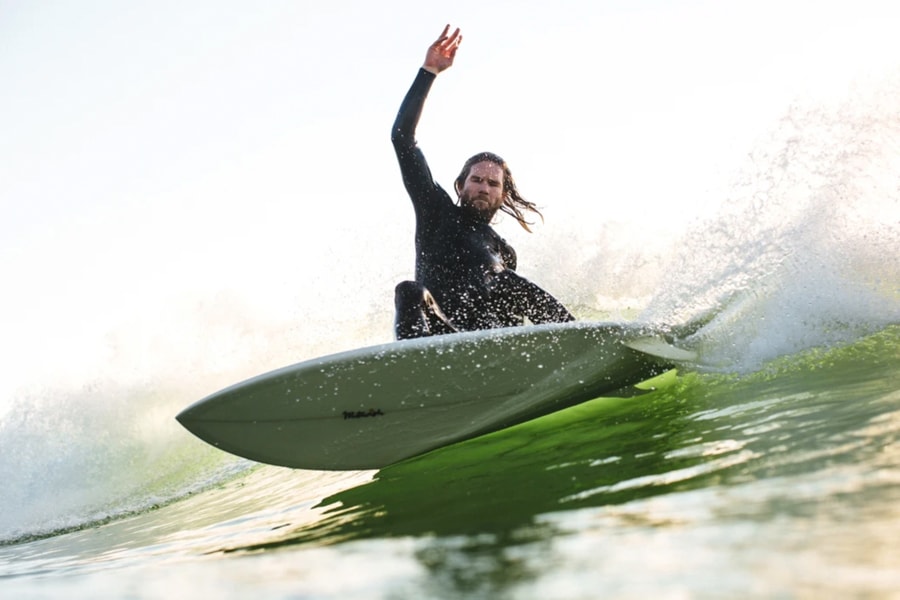
Twin fins on fish surfboards go together like peanut butter and jelly (or whatever amazing combination of food you fancy) so “twinnies” are commonplace in the world of fish jargon. But, like most things in this wild multi-dimensional world we live in, fish surfboards can be ridden (and are made) with any assortment of fin setups your heart desires depending on your wave-shredding preferences and the conditions.
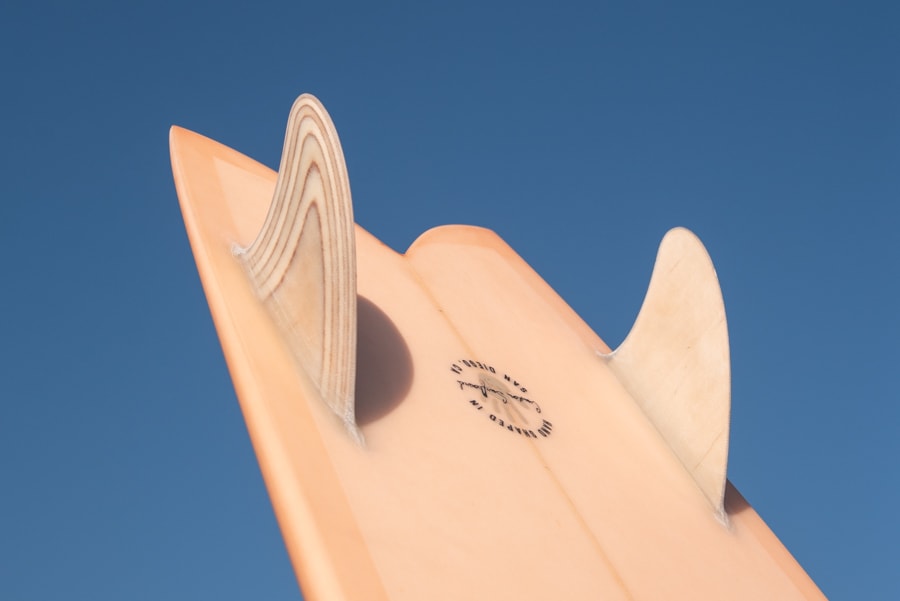
Some general fin guidelines:
- Want that classic retro fish feel all loose and flowing? Opt for two fins and go with a twinnie.
- Want a little more drive, hold through turns, and performance? Opt for four fins and pick up a quad.
- Not sure what you want to get? Snag a five fin set up and ride it as a thruster, quad, or twin fin. Although it likely won’t be ideal placement for twin fins which are usually more or less placed between outer fins and inner fins on your typical quad.
A Brief History of the Fish Surfboard
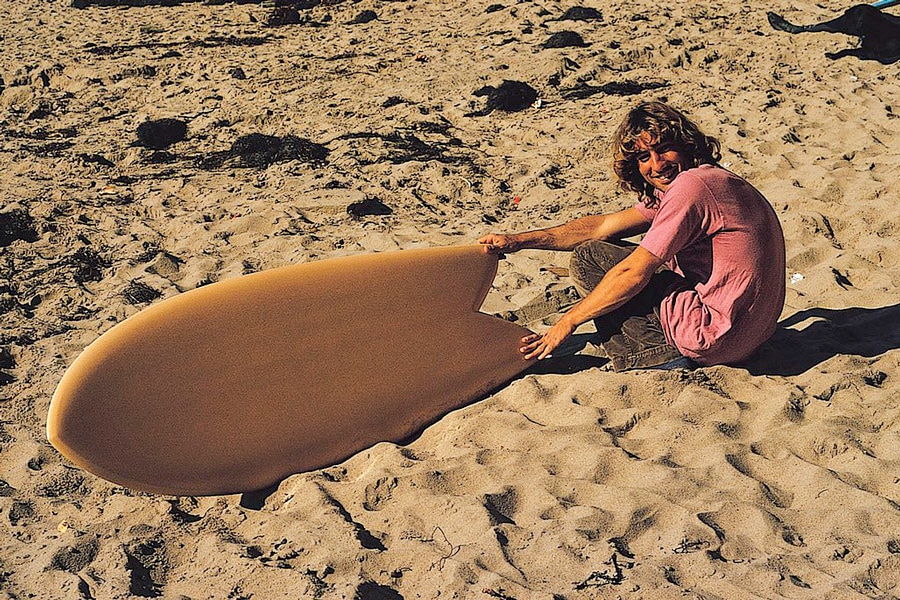
In a nutshell, in 1967 a San Diego-based kneeboarder, Steve Lis, originally designed what is now known as the fish surfboard because he wanted to push the limits of his radical kneeboarding skills at the reefs of La Jolla and shred the gnar a little bit harder.
At only 16 years old, Lis transformed a broken-in-half longboard into his first fish shape – and while no one was privy at the time, the Fish would later be credited as a huge advance in surfboard design which helped drive the shortboard revolution.
By the early 70s, Steve’s design had made its way through the ranks to some notable professional surfers. In 1972, top-surfers Jim Blears and David Nuuhiwa surfed fish-inspired designs at the World Championships in San Diego in some rather crappy surf where they won first and second place. It’s thought that this contributed to the fish gaining the reputation of being a good choice for mushy lack-luster surf (which fish shapes definitely are in my experience).
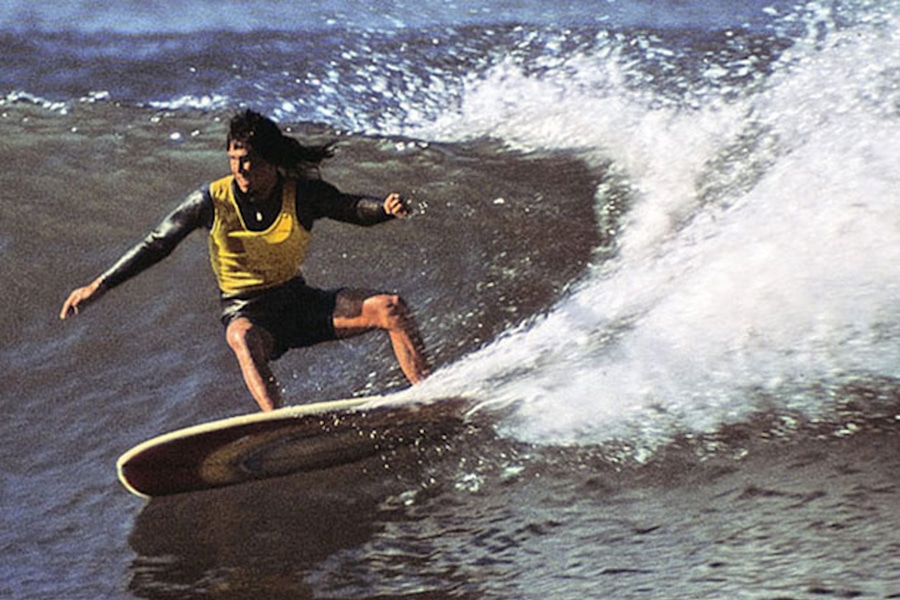
If you’re not familiar with present-day World Championship surfing, riding a fish on the Championship circuit is unheard of these days so that’s really cool that some guys were riding fish in professional contests back in the day.
Anyway, some years later, Australian Surfer Mark Richards further tweaked and modified the fish design taking notes from shapers’ fish designs (like Reno Abellira) to be more performance-oriented and similar to shortboards of that era and MR surfed his hybrid performance twin fin to a triumphant streak of four championship titles from 1979 – 1982.
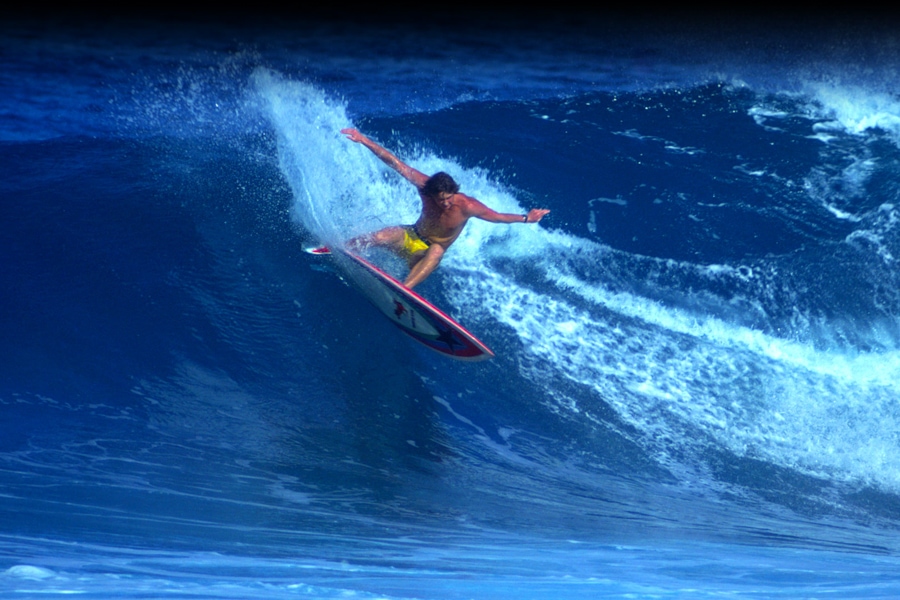
Over the next decade or so the popularity of the fish lost its steam as shortboard surfboard designs like the thruster were considered to be more progressive and took over as the go-to shape. It wasn’t until the 90s when world-renowned surfboard shaper Matt Biolos (and others) shaped some fish-inspired designs breathing life and interest back into all sorts of different fish and groveler designs.
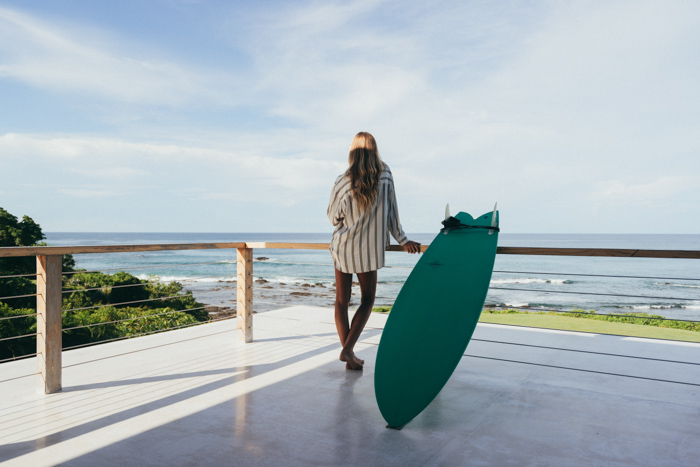
Epic surf trips made easy.
Explore luxury done-for-you surf vacations with Lush Palm Private Retreats.
What are Fish Surfboards Good for?
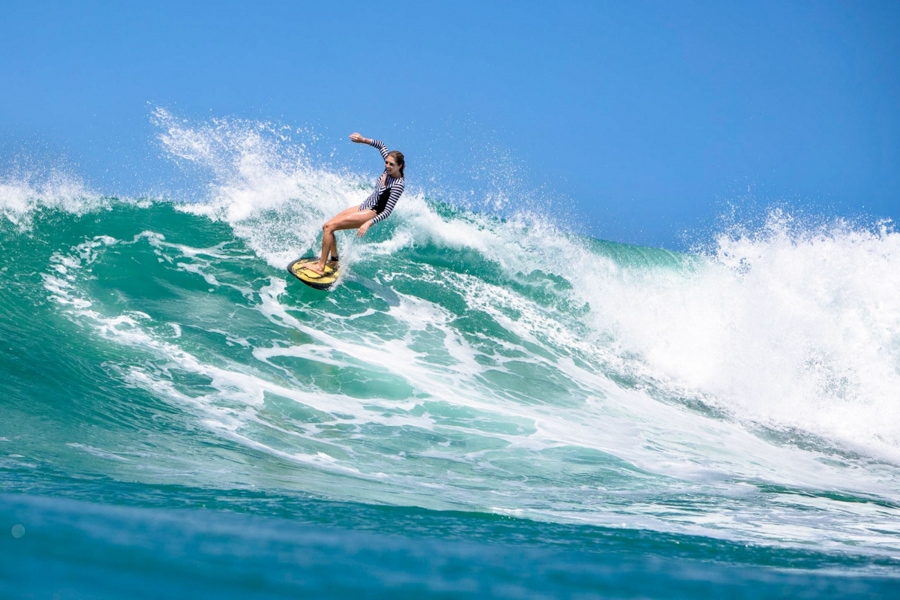
Fish surfboards are quite versatile so you’re bound to see surfers riding them in a wide variety of conditions from mushy (or hollow!) beach breaks to reefs and points. When I went on a yearlong round-the-world surf trip one of the two surfboards I brought along was my trusty 5’8” retro fish with a quad fin setup. I surfed it all over the globe in knee-high slop to overhead reefs and points and it’s still one of my go-to boards for 80% of the surf we get in San Diego.
I think for the average surfer, fish surfboards are especially good for cruisey and mellow reefs or beach breaks and long rippable points in the waist-high to overhead range because they’re super fast and easily generate speed which always helps in slower conditions, but Lis’ original design was actually intended for more powerful and hollow reef breaks which many expert surfers demonstrate in all the epic fish surf films nowadays. So if you’re wondering if you can surf a fish in big waves, you absolutely can if you’ve got the skills for it!
Case in point – this Deus Ex Machina short film featuring one of the masters of riding tiny fish on beefy waves, Harrison Roach:
A Few Key Benefits of Fish
- Speed: With a flatter rocker and wider outline, fish surfboards are super fast down the line. Generating speed is a huge benefit because it’s an important factor in surfing your best, performing maneuvers, and making sections.
- Paddlebility: With the extra width and thickness, fish surfboards tend to have more volume and buoyancy – pair that with the flatter rocker and they paddle pretty darn well which typically translates to catching more waves and having more fun.
- Versatility: While fish were originally designed for hollow, punchy reef breaks, they have rightfully earned the reputation for being super fun in mushy lack-luster surf. These boards are very versatile and the only limits of a fish are the limits of your own imagination (and surf ability).
Just for fun, here’s a rad clip of Dave Rastovich talking about and surfing his quiver of Gary McNeill surfboards. The first two are twin-fin fish.
Are Fish Surfboards Good for Beginners?
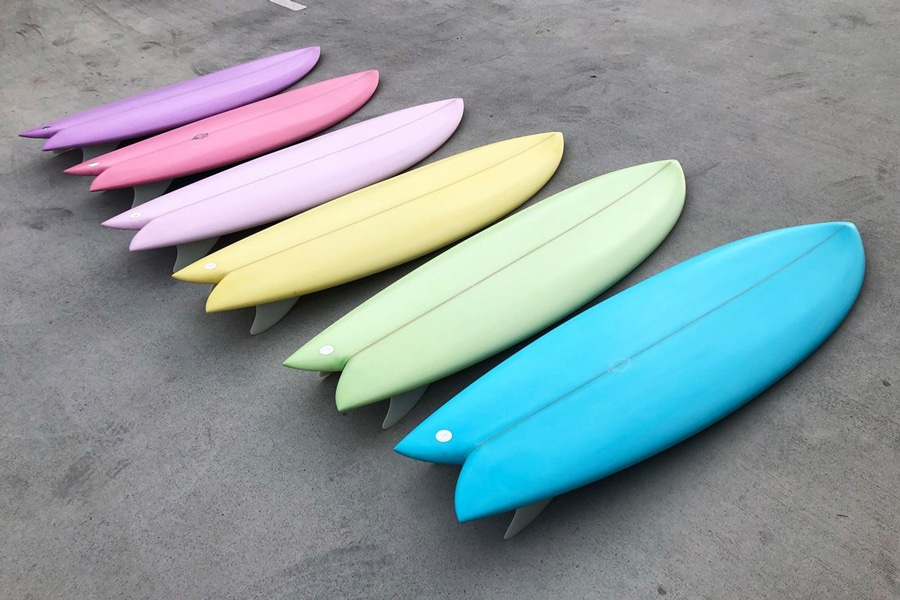
It really depends on your skill level and where you’re at in your beginner journey. I think the term beginner can mean a lot of different things to different people, so let me break it down for you a bit from my perspective. For the average person, learning to surf is a slow and challenging progression, and most people are stuck in the beginner realm for quite some time (maybe even indefinitely).
So there are absolute beginners who are brand new to surfing, there are beginners who have been at it for some time but are still working on the fundamentals, and then there are advanced beginners who have nailed the fundamentals and are getting a hang of surfing but ultimately still fall into the beginner category.
If you’re just starting out on your surfing journey, then no, a fish surfboard isn’t the ideal board for you. You’re best to start off on a good size mid-length or longboard depending on your height, weight, skill, fitness, and overall determination. If that’s you, check out our article about Best Beginner Surfboards or Soft Top Surfboards for some boards that are a great starting point. And for a comprehensive overview of the different types of surfboard shapes, check out this Surfboard Guide.
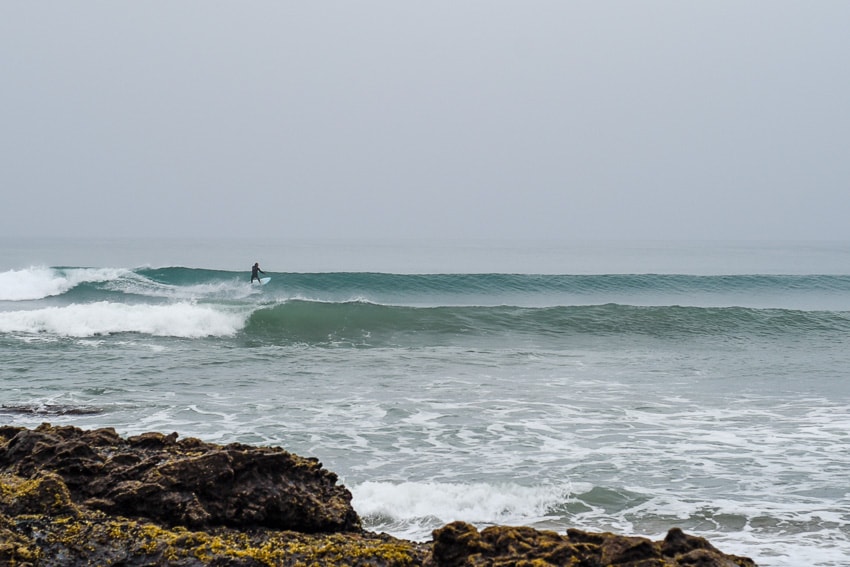
Now, once you’ve been at it for some time and have nailed the fundamentals, then a fish surfboard could be a good choice. But again, it’s not black and white. For instance, it probably wouldn’t be ideal to go from a 9-foot beginner-friendly longboard down to a traditional little retro fish shape.
A small fish surfboard can be fast, loose, and squirrely so that likely wouldn’t be a fun transition and learning curve. That said, if you are keen on picking up a fish for whatever reason and you’ve nailed the fundamentals but are still in the beginner realm, I’d suggest getting either a foamie fish or something with a fishy outline but with a bit more size, or a combination of the two.
What Size Fish Surfboard Should I Get?
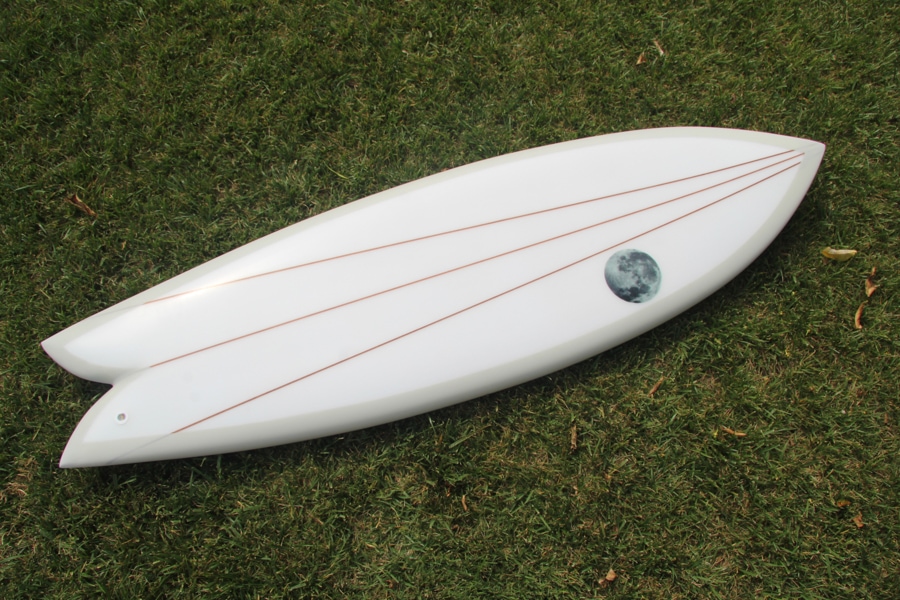
That’s a loaded question without a one-size-fits-all answer. As I mentioned above, generally speaking, if you’re looking to get a pretty standard old school retro fish surfboard shape and you’re an average surfer and average weight for your height, you’ll likely want to be looking for something about 2 – 6 inches shorter than your height. If in doubt, start with a fish around your height, see if you like it, and adjust accordingly.
With so many takes on retro fish designs out there these days along with other variables like the type of waves you plan to surf and your own shred-ability, there can be more to consider.
If you like a lot of extra float or you’re carrying around some extra weight from all those delicious IPAs you’ve consumed the last few months, then maybe consider erroring on the side some extra length and volume. Or, if it’s a more slender narrow fish design, then you’ll probably want to get something closer to your actual height or just an inch or two shorter than you are tall.

Where to Buy a Fish Surfboard
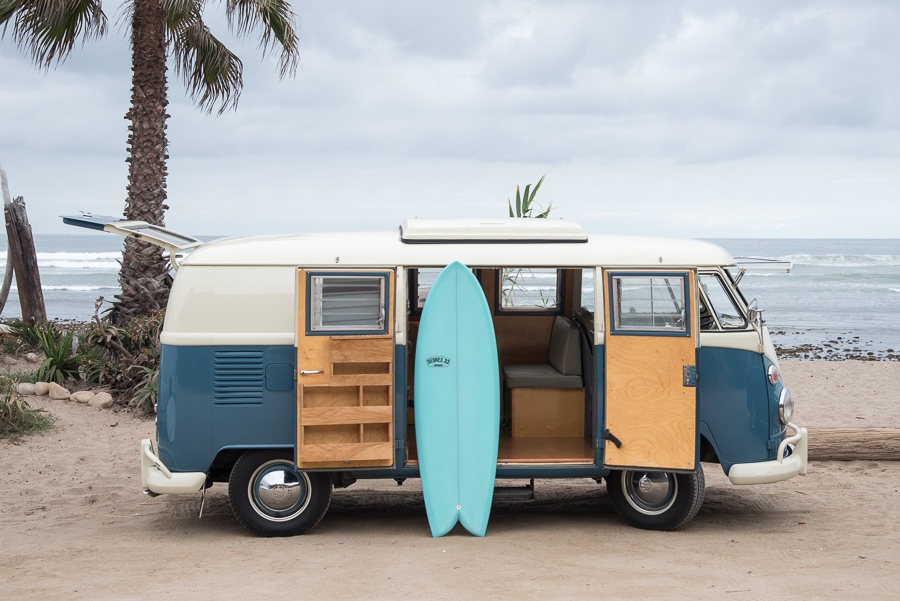
If you live near some good surf shops that stock a variety of boards then of course that’s always an option, or you can work with a shaper to custom shape a board.
One of the best places to buy a fish surfboard online is Degree 33 Surfboards. Degree 33 is an authentic San Diego-based surf company with a great assortment of fish surfboards (and lots of other shapes) in stock, and they offer free shipping to the contiguous US. You can check out their modern retro fish here (and below), and they also make a soft top fish as well.
If you would like to continue your fish enlightenment, firstly, I highly recommend starting to surf one, and second, check out FISH, a fantastic documentary about the history of the fish surfboard design and its influence on surf culture. Below is the trailer and you can rent the film via Vimeo.
Questions, comments, or want to share your love of fish with the world?
Leave a comment below. Cheers!

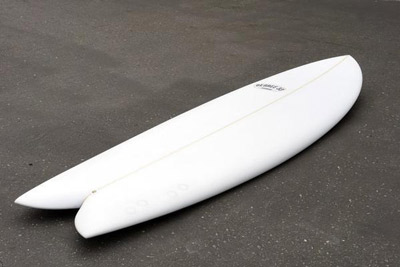
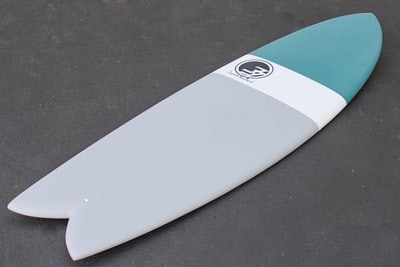
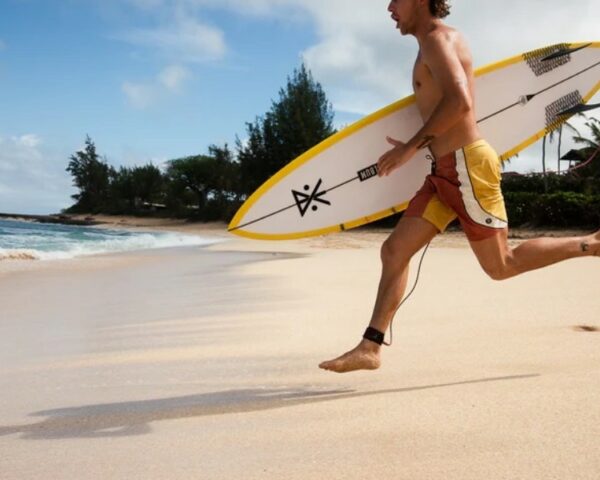

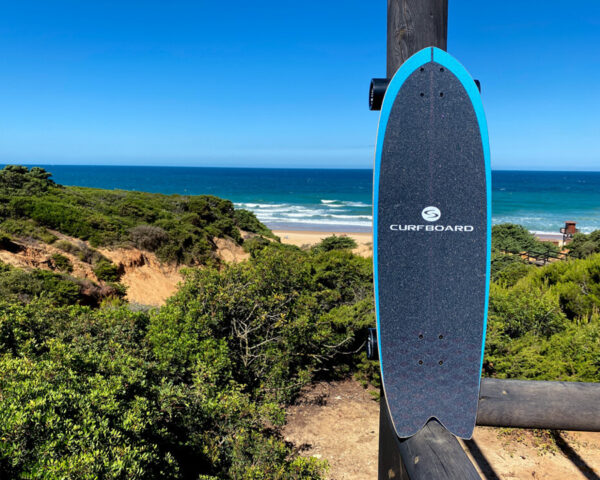

In the 70’s I had a few Nuuhiwa Fishes and was always known as the Fish guy, later I had an MR Rocket Fish. Last short board I purchased was a 6′ single fin Summer Fish and then stopped surfing for a long time. When I gave it another go in the early 90’s I tried my old Summer Fish but weighing in at 220lbs it was tuff so I bought an 8′ long board and was last riding a 10’0 but have always dreamed of getting back on a fish but I know it will never happen. Happy Surfing
Thanks for reminiscing and sharing a little bit about your surfing journey, Michael. Maybe you blend your fishy past with your longboarding present and try out some sort of XL mega fish. Happy surfing!
Degree 33 specializes in inexpensive mainly offshore built boards that are of a fair quality. They do work with Bill Minard who is in fact an underground and greatly skilled San Diego shapers that has worked with the board builders in the area. He does some design work with them and shapes and does customs for them. If you want a real San Diego Fish reach out to Mitsven, Larmo, Hall, Warner, Ellington, Christenson etc. All local gifted shapers who have been building them for at least 20 years or more.
Thanks for stopping by, Bird! Yeah, Degree 33 definitely has a great selection of budget-friendly entry-level surfboards on offer and does some manufacturing offshore to help keep the cost of their entry-level boards down. And as you suggested, Bill Minard, who is an excellent and very well-respected shaper shapes all of their poly and custom surfboards for those looking for a more finely-tuned and hand-shaped board. And as you suggested, all of the other local San Diego shapers you mentioned are excellent options for fish surfboards. Cheers
Great article! I’ve got fish on the brain! What are your thoughts on a foam fish vs a standard hard board construction?
Thanks! Depends on your use case. Foamies are always fun boards to have in different shapes and could be a good choice when learning or practicing pulling into little barrels as they don’t hit as hard. A hard board construction is always going to be that much more responsive and performant. Just depends on what you’re looking for. They are a lot of cool hybrid, soft top, hard bottom construction boards out there now that try to blend the benefits of both constructions.
Great article!! What are your thoughts on ridding other shapes as twinnies? I’m still a beginner and have a blast ridding aFirewire Seaside (which is kinda fishy) but been playing around with a Firewire Baked Potato ( fat groveler) with Keels for really crappy days and it seems to work great. Thanks!
Thanks Francisco! It’s always fun and recommended to experiment as that’s how you get a better feel and understanding of how things work. I bet it felt pretty loose! I’ve done the same throwing a twin fin set up on a short, flat, groveler that had a 5-fin set up option and it went alright (very slidey and loose but worked). But typically twin fins are ideally placed somewhere in-between your outer fins and side bites on a traditional quad fin set up. So I think in most all cases you’d find the twin fins to work better when the board is properly shaped for that. But no harm in experimenting!
Hi Eric,
Thanks a lot for this very detailed article.
I’m currently using a 7’4 EPS (epoxy-soft) board with 72L of volume. I’m probably still a beginner, having surfed 2-3 times per week for the last year.
I’d like to get a fish but not sure of the size/volume to go for. Knowing that I’m 6’4 height and 80kg (so quite slim and tall), what would be your recommendation for the board size and/or volume?
Thanks a lot in advance,
Daniel
Hi Daniel, it’s hard to say without knowing more about your level and ability. Considering your height and beginner level, I’d probably recommend something longer in the 6’6 range until you’re more of an intermediate which should still have quite a bit of volume, perhaps 50-60L ideally. Once you’re around the intermediate level then you can look for a fish closer to your height or a couple of inches shorter like 6’0 – 6’2, but foam and stability are your friends when progressing from longer boards to shorter boards. Hope this helps!
This was a great and informative article, thank you Eric. I do have a question that perhaps you can enlighten me on. I was recently loaned and allowed to keep at my disposal a 7’8″ fish by Noreaster surf here in Massachusetts. I took it out the other day for the first time and noticed that it’s quicker than a preferred long board (9’6″) that I’m used to. Since it’s fall heading into winter and we’re in 5-4 wetsuits w/ gloves and booties, that did not help with the experience as I felt like I lost some of kinesthetic awareness w/ bare feet and hands as well as a more mobile, thinner wetsuit. I did realize the fish requires a faster pop-up and low profile stance. And the board is ‘quick!’ What type of break do I want to be looking for when riding this type of board? Tbh, I do not consider myself to be an aggressive surfer, but feel like this board certainly changes things up versus a long board. If you have an info or another resource that I can refer to regarding surfing this type of board, it will be great appreciated. Also, I came across the Rusty Moby Fish and it seems like it had a pretty decent description of a larger fish.
Thank you for your time and look forward to hearing back from you.
Hi Steve, thanks for stopping by! That’s a loaded question as there is a lot to unpack here. But here’s my perspective on the matter. While certain board templates are certainly more suitable for certain types of waves, it is ultimately the individual surfers ability to surf a board in different types of waves that dictates what can be done or not with any given board. Fish surfboards are known to be super versatile and are commonly surfed in everything from reef breaks, to beach breaks and points. To generalize wave type preferences though, more novice to intermediate surfers might prefer to surf a slower wave, but that could just be a matter of going at the right tides at any given break. For instance, some reefs or breach breaks are slow, fat, and mushy during a higher tide, which would give a novice surfer more time to standup and it would be a more forgiving and user-friendly ride. So it’s not necessarily about where to go, but more so about when you go considering the swell size, direction, tides, wides, etc. All that to say that the board you are referring to can be super fun to surf on any given day at any given break, it’s just more about what is happening with the waves, tides, and conditions, etc, during that specific session. Also, sometimes when you surf a new shape you’re not used to, it can feel really fast, loose, squirrely, and so on. It can also just be a matter of getting familiar with the feeling. But generally speaking, based on your comments, you’d probably have a blast on that board at a cruisy pointbreak or a mellow reef break. Hope my input helps on your quest to figure out the best type of wave for that board! Good luck!
Great article! I have a question though that wasn’t mentioned. Can an old guy like me, who can’t pop up on a board anymore have fun riding a fish like a bodyboard? I’ve been sup surfing for many years but I’m tired of battling off shore winds and white water and now my balance isn’t quite what it used to be. Don’t really want to switch to a bodyboard because o f the swim fins. I’m 5’10” 160 lbs and wonder if a fish could work and if so what size? Thanks for any advice you can give.
Thanks Flip! I’d say having fun is in the eye of the beholder 😉 So sure, you can have fun out there riding a fish prone, why not! I’ve ridden waves prone after a failed or late pop up, or when dropping down to my stomach to come in from a session and always like to make the most of riding the shoulder and sections. Yea, a 5’10” would probably be a good size fish with plenty of foam to make catching waves easier. I ride a 5’8″ and am 185 lbs, but I think the extra size would help you with getting into waves. Cheers and have fun out there, no matter what!
want to know the most larger fish board work good
Always seen as summer small wave boards but a well made fish properly foiled and planned is so much more…great article!!
Absolutely!
Thanks for writing this! Really well written with lots of awesome and applicable information. Planning on grabbing one soon!
You’re welcome, Jeremy! Thanks for the kind feedback, glad you liked it. You’ll be stoked you did once you pick one up!
Thanks for the write-up… Picking one up this summer!